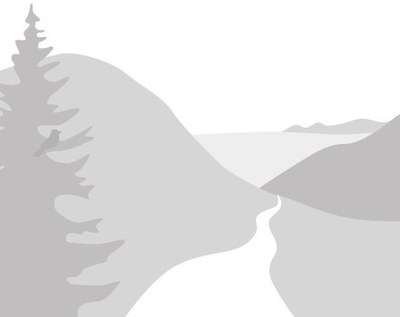
Trip Report
Intermediate Alpine Climb - Chair Peak/Northeast Buttress (winter)
Late-season climb of the winter classic.
- Fri, Apr 2, 2021
- Intermediate Alpine Climb - Chair Peak/Northeast Buttress (winter)
- Chair Peak/Northeast Buttress (winter)
- Climbing
- Successful
-

- Road suitable for all vehicles
-
Good snow on the approach, no problems walking on it in snowshoes. Did not have to break trail on the way up. Ice somewhat thin and already melting out. Snow on the face sticky and offering quite good footing on the way up. Ice step less than body length at this point. First rappel gully still ok to downclimb. Second rappel gully initially sugary and powdery snow with no structural integrity, but improves enough by the end of the rappel to be reasonably safe on a downclimb. Crown possible to negotiate by traversing to climber's left, after which it's a simple downclimb and walk out. Snow on the descent soft, postholing in many places.
As always, I had to cancel and reschedule this trip several times due to weather or snow conditions not looking right. It would have been easier to do it mid-week, but some of us have been too busy at work to pull that off.
Fortunately, we had the last opportunity to do it before the winter was over, with Friday looking not perfect, but reasonable. With a dry mid-week and a warm Wednesday, snow had the chance to settle somewhat. We expected and saw a "low" avy risk rating from NWAC at climbing elevations. Wind in the 10-15mph range, expected temperatures 27-28F overnight and throughout the day, and partially cloudy skies. We decided that this was looking promising enough to give it a shot, and go to see Chair Peak up close. The conditioning benefit would still be there, and the only downside was a little less sleep (you definitely want to do this climb as early in the day as is humanely possible).
Got up before 3am, arrived at the Alpental lot 4:30m, hit the trail 5am as planned. We started to walk initially without snowshoes, but had to put them on after about 10-15 min. as we hit some softer patches. As usual, in total a little under an hour to the Source Lake, plus another ~1.5h to reach a good spot for a gear stash.
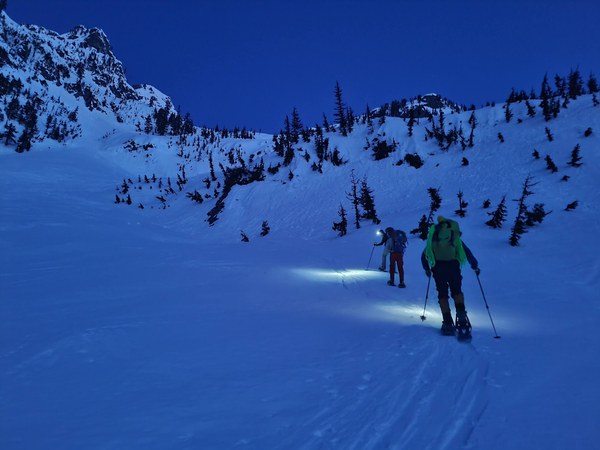
The moon was about 70% full, and soon after we gained a bit of elevation, we could see it hiding behind the surrounding peaks. It accompanied us throughout most of the approach.
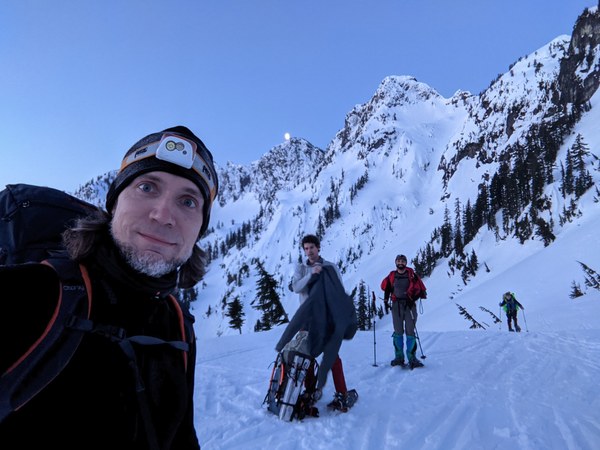
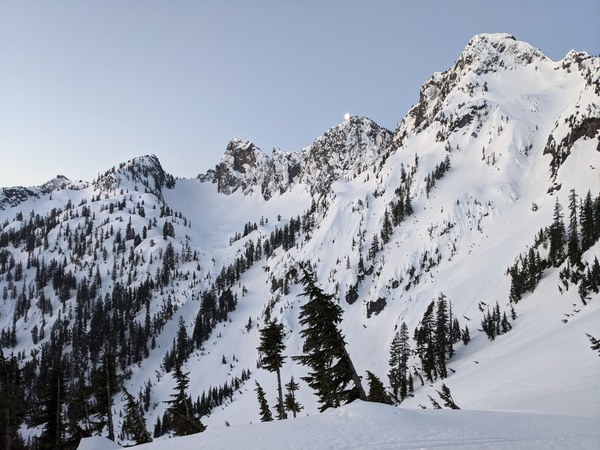
As it is later in the season, it started to get bright pretty quickly. A thought crossed my mind that perhaps we could have started an hour sooner, although getting almost no sleep is also a risk factor that needs to be weighed against other risks. Most of us clocked in about 3 hours before the climb, which was not great, but ok.
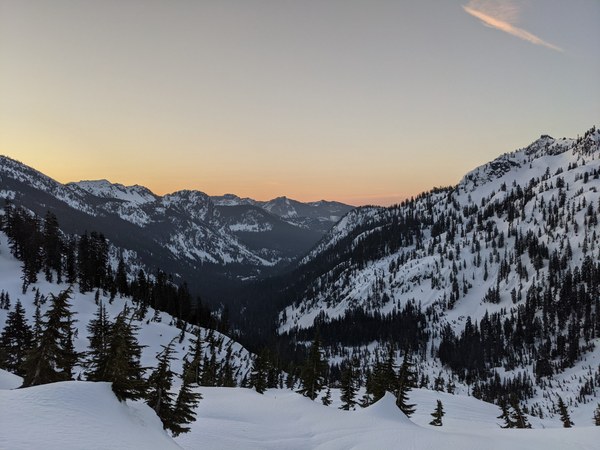
On the approach, we saw lots of assorted avy debris from the last couple of weeks, including no doubt some from the warm Wednesday this week, many in the basin right below Chair.
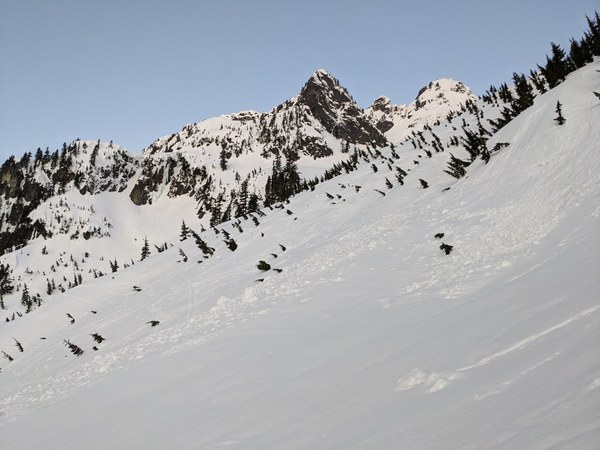
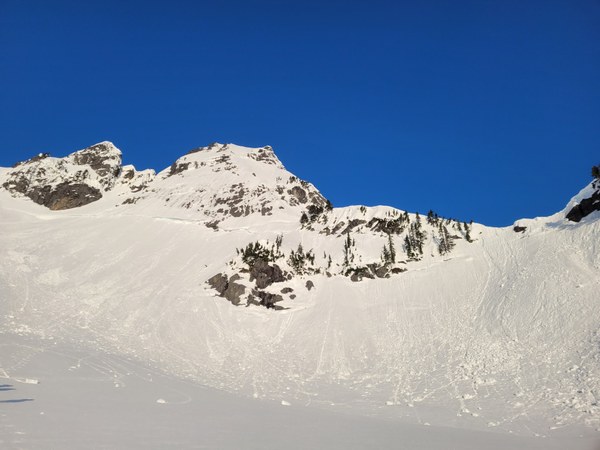
Since the snow was somewhat easier to negotiate in snowshoes, we picked our gear stash to be on the slope slightly southeast of the climb base, at around 5300. We arrived there at around 7:30am, and dug out platforms to make ourselves comfortable. We left snowshoes and poles behind, put on harnesses, climbing gear and crampons, but we did not rope up just yet.
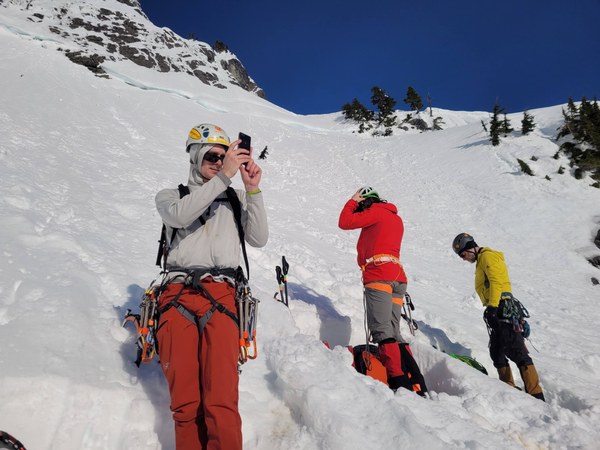
This time, fortunately, we were not being chased by hords of other climbers, so we took the time we needed to rest and refuel. We departed the gear stash by around 8:15am.
In order to get to the base of the climb, we had to negotiate the crown of the massive avalanche earlier this year. Fortunately, by now this crown has sagged quite a bit in places, and climber's right it didn't look nearly as menacing as I had imagined it might.
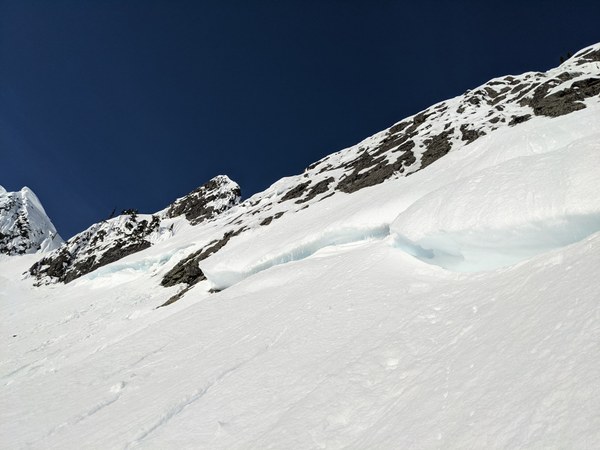
Some in the party ahead managed to climb through it without issue. Whether it's being heavier, dumb luck, or some other factor, I soon found myself punching through chest-deep into a mystery "bergschrund" (not really). Yikes! As I was digging myself out, I realized I need to work on my stretching regimen - my leg joints were clearly not as flexible as I needed them to be. Moved down a bit, and decided to gain safer ground towards the ridge that separates the approach basin from the northern flanks of Chair. I would recommend climbing that ridge before approaching the base of the climb, rather than going straight for it. Although the runout is not terrible, the slope here is steep, and arresting a fall would not be possible.
Given that conditions were not going to be optimal and we did not have detailed recent reports, we decided not to attempt the right variation, expecting it to be thin, mixed, and sketchy. We opted for the left side, and started to set the base anchor right under at about 8:45am.
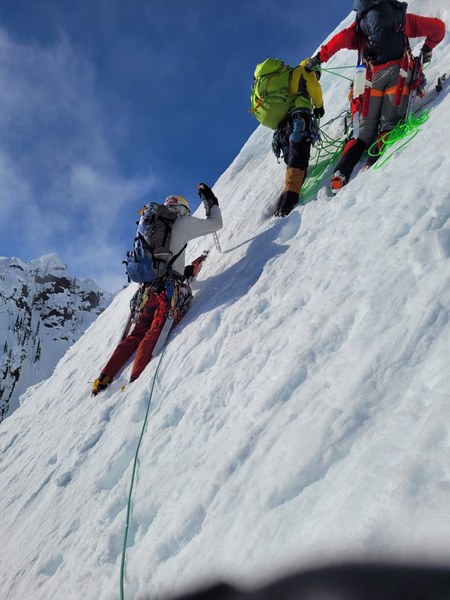
With this being fairly late in the season, the ice was not that great. Still there, but thinner, with screws bottoming out or hitting air pockets. Nevertheless, we were able to build a 3-point anchor with screws and attach ourselves to it to gain the safety of the rope.
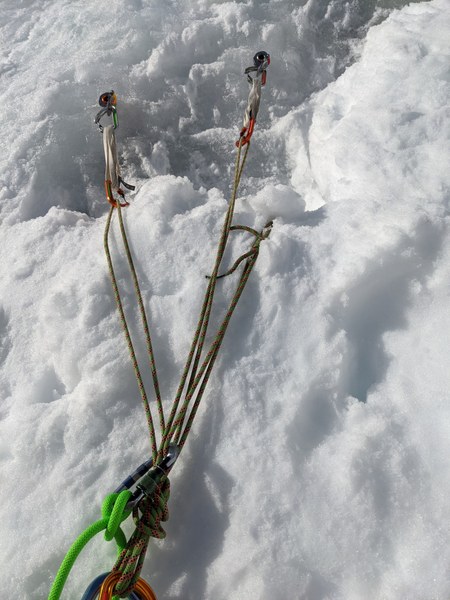
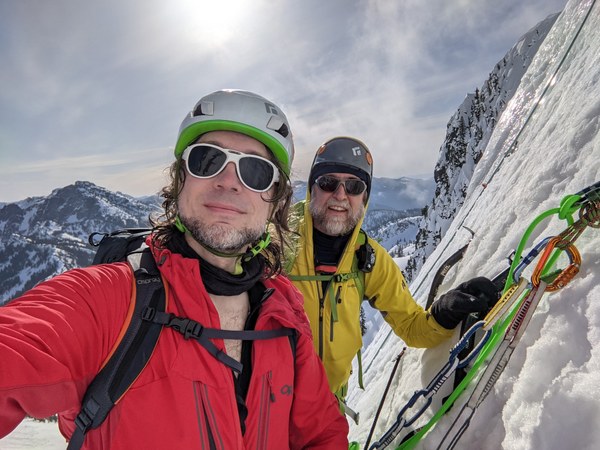
The other rope team found good ice closer to the rock below us and also managed to place two good screws. Ashish on belay:
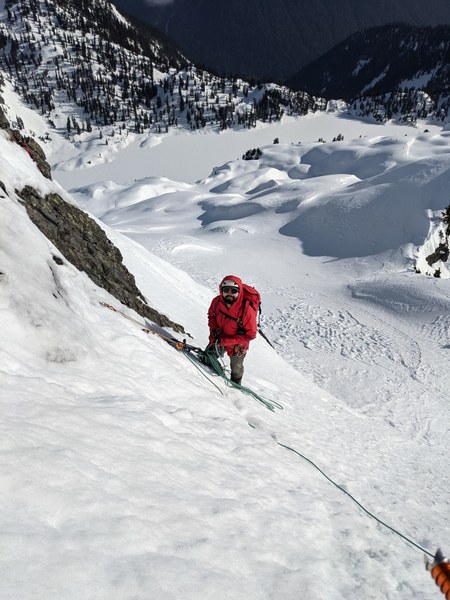
The first rope team set out to climb around 9am. The first pitch took them an hour or so, quite a bit longer than expected. We weren't sure exactly why, but the ice did look somewhat on the thin side, and it was clearly already melting out.
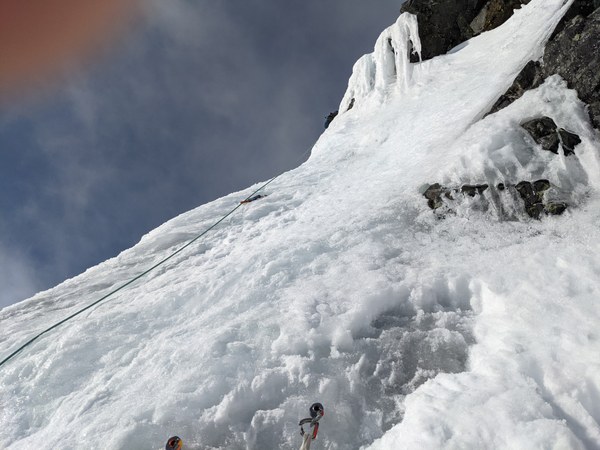
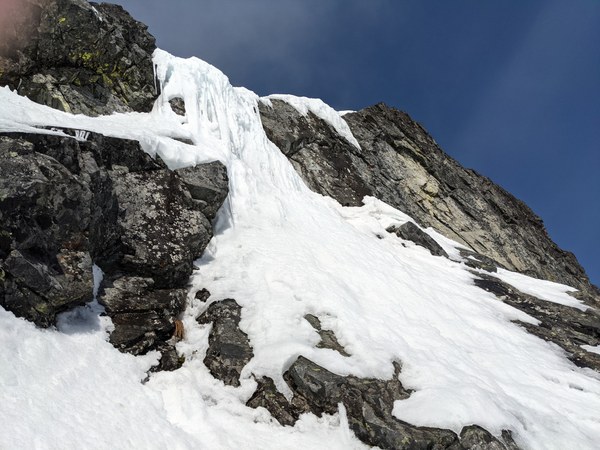
Indeed, as I was soon about to find out myself, the first pitch was indeed a little more intense and sustained this time around compared to last year. The ice was not great, and protection was a bit harder to come by than I remember it from last time, somewhat raising the excitement level while on the sharp end, although on the flip side, due to the melting, we were able to discover an unexpected bonus rusty piton right below the buldge that came handy, as there wasn't really a good screw placement any more in this spot. Above the bulge, there was some rock exposed from under melted-out snow and ice, and I had to use a few mixed moves, hooking tools on the rock, to get past this and move over a section of snow over rock. Not having climbed much this winter definitely did not help, and the tips and tricks from last year's trip to Bozeman really came handy, as I needed to give my burning calves a rest part of the way through.
Meeting the first team at the tree:
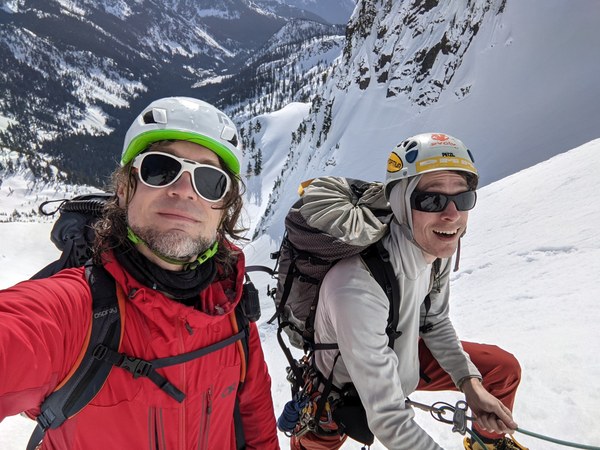
Looking down at the end of the first pitch:
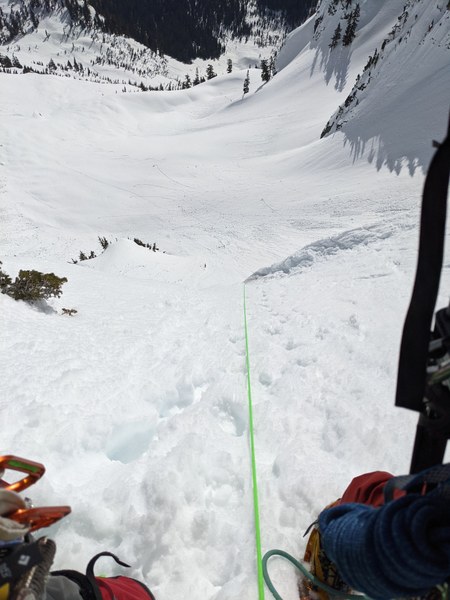
As usual, the second and third pitches were "combined" by simul-climbing, although with a 70m rope, there really only may have been 30-40 feet of simuling before the lead reached the ice step and was able to clip to an anchor made by the first party.
Looking down from the ice step on the simul-pitch:
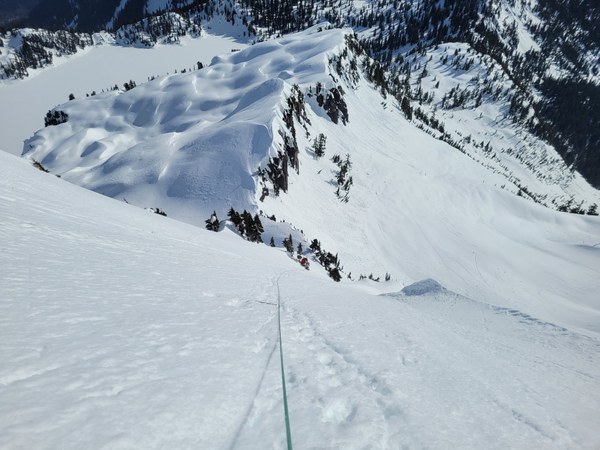
Protection during the simul-pitch was pickets-only, as there was no rock to be found along the way except far off to the side, which was definitely not great, but as noted above, that part was really very short. Unlike snow on the approach, the snow on the simul-pitch and higher up was relatively heavy and grabby, and packed pretty well, so good steps were made that enabled for a relatively secure travel. Overall, nothing remarkable to say about this pitch.
At the ice step anchor:
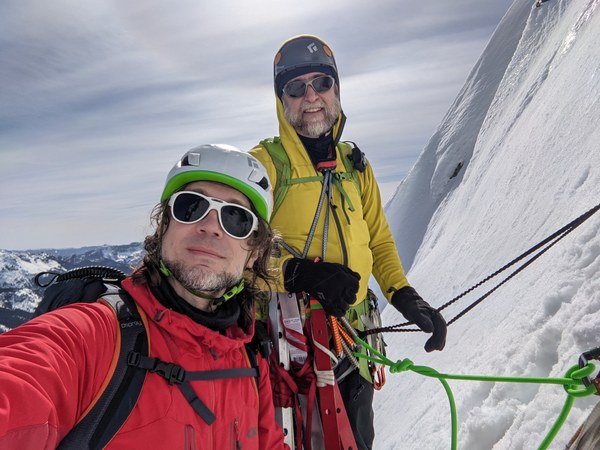
We found the ice step to be less than body length, and clearly in the process of decomposition. As we stood there, we saw water starting to drip from the icicles in the heat of the sun. The screws should probably also have been protected with snow or backed up, since they were melting out at a scarily fast pace.
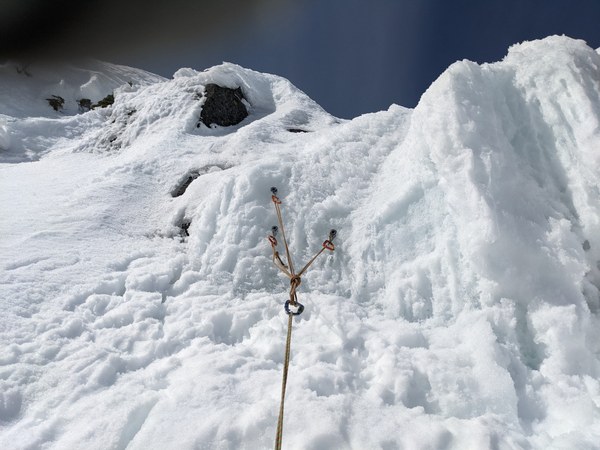
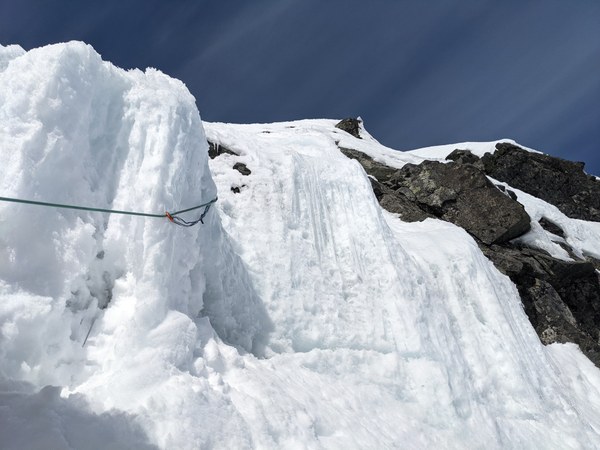
As short as it was, the ice step offered sufficient protection to the small ice projectiles wheezing by overhead, some definitely with the energy to cause damage to the belayer.
Also, as short as it was, it's certainly steep and scary up there, and a fall wouldn't be good. When in doubt, don't look down or to the side, and just tunnel-vision on your pick, crampon, and screw placements.
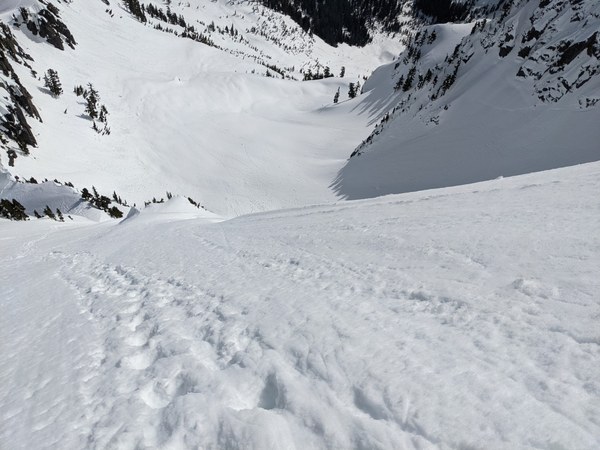

Ashish negotiating the ice step:
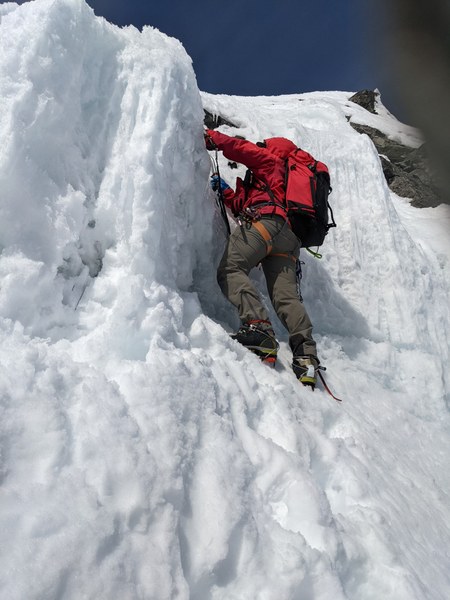
The anchor on the slope above the ice step had to be pickets-only, as again there wasn't really any rock to make a better one, except very far off to the side where it wouldn't be either very safe or convenient to traverse. The part of the climb where one takes off the last ice screw and safety lies in the pickets in crappy snow is perhaps the one to be most careful about, but fortunately, that slope eases off very quickly, and albeit the snow was softening a little by then, it was still offering pretty good and secure footing.
After the fifth pitch, one tops out on a small ridge where a good picket can be installed, and then a false summit, where a small tree poking from beneath the snow can be slung for belay. The health of that tree is somewhat debatable, but as the rope at that point goes over the ridge, and the lefotver pitch is easy, meat belay would also be sufficient.
We all topped out by at 12:30pm, or after about 2.5 hours of climbing, which was a little faster than expected.
From the false summit, one normally unropes and scrambles to the summit proper, but given the late season conditions and above the gully not being a great place to blow a step and fall while down-climbing, we played it extra safe, and we belayed the very short walk to the summit as well. Some will undoubtedly find it excessive, but if the conditions leave a trace of doubt in mind, and protection is readily available and cheap, why not take it.
Jeff tagging the summit:

Ashish and Logan celebrating their hard-earned ice credits:
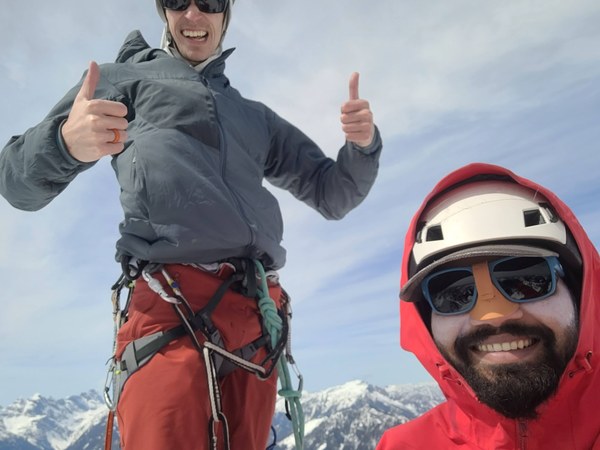
After summitting the peak, the climbers were drunk with excitement, so getting level shots has proven to be rather difficult.
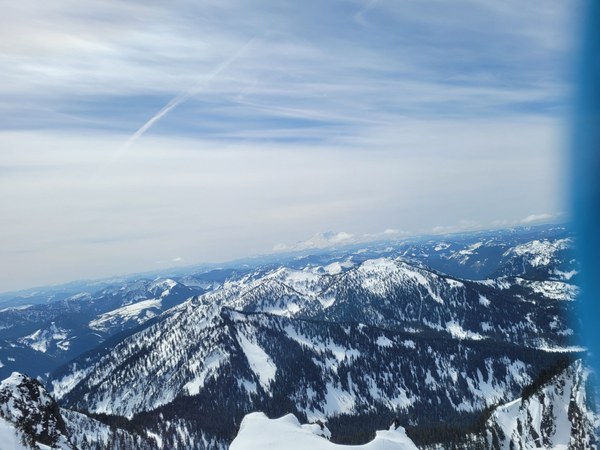
A look from the summit down on the false summit:
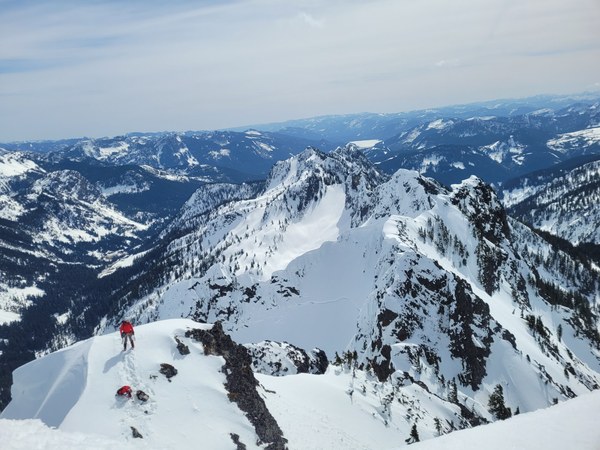
Contrary to what the forecast promised, the skies were clear throughout that day, so as much as it was fun being on the summit, and despite topping out slightly ahead of schedule, we did not want to spend any longer up there than necessary, as the sun meant the snow softening up and the potential dangers lurking on the descent. Getting to the rappel was a priority.
I originally thought we'd start from the usual sit-and-spin rappel tree, but couldn't immediately see it, the downclimb gully was looking reasonable, and having experienced rope stuckness on the first rappel myself (and knowing it happens regularly), the merit of sticking with the plan wasn't immediately apparent. After pondering this for a moment, we decided to forego the regular first rappel, and use the downclimb gully instead. The downclimb gully has a tree at the top that's still somewhat alive, but that I wouldn't trust. We still rigged a rappel on it, but more as an extra hand line to protect a slip, and agreed to not try and take body weight on it. Some of us plunged stepped, and some downclimbed with one tool, while using this rappel-handline. Downclimbing started around 1:50pm, and took about 15 minutes per climber.
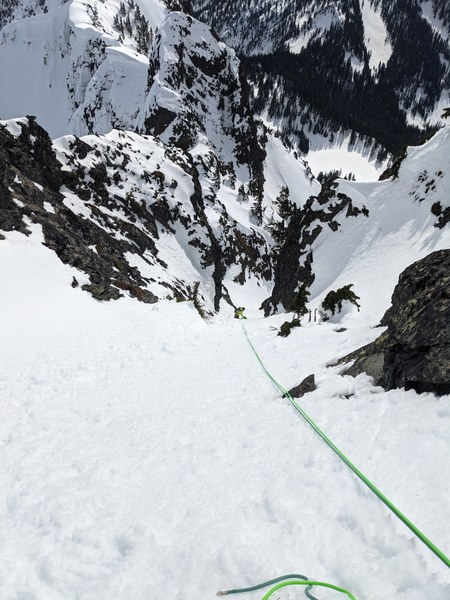
A double rappel was just enough to leave 30 foot of so of downclimbing on relatively easy terrain to reach the three rusty pitons that represent the beginning of the second (mandatory) rappel. Beware of snow thinly covering flat sheets of rocks on the climber's right of the end of the downclimb, possibly risking a slip, so be sure not to get too close. Also, be sure to stay well away from the edge of the cornice on top of the second rappel gully, next to the pitons.
As usual, getting the second rappel started requires punching a channel through the cornice. We already had a small tunnel made by parties climbing it a few weeks ago, but it was very narrow, and required quite a bit of twisting and turning action to avoid the gear on one side or the other catching. In retrospect, it would've been better to at least partially degear before the rappel.
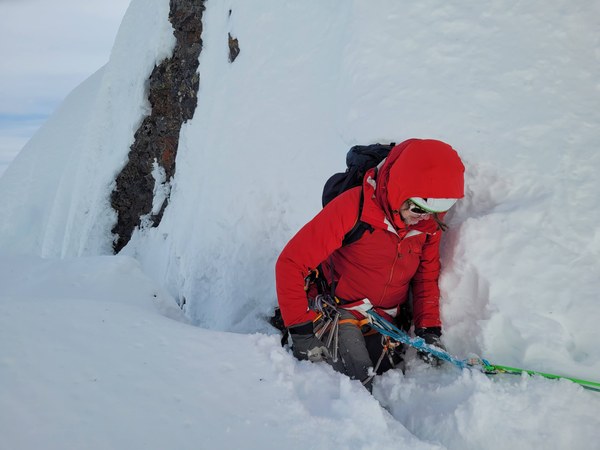
Second rappel started 2:30 or so, and took about 20 minutes per climber. Unlike the first rappel, it is steep, in places almost vertical. Snow in this shaded gully was also very different, sugary and powdery, and offering almost no support. Feeling this snow on rappel disintegrate under my sinking feet, I was quite concerned about the upcoming downclimb. One of the climbers has later punched through into a moat that would have been deep enough to swallow a person, if it were not for being on rappel. Fortunately, the rusty pitons could be trusted to accept full body weight.
Once at the end of the rope, not yet sure about the integrity of the snow, I needed a bit of extra time to equalize the ends through my device (we had 70m and 60m ropes) to allow me to get just a bit lower to explore the slope and look for anchor options in case a third rappel is needed, which took a bit of time, as due to some miscommunication, the next climber already installed a Prusik on the rappel ropes, which interfered with my attemps to equalize the ends. Fortunately, the radios still worked, and we eventually managed to get this sorted.
I remembered from recent trip reports that someone did a third rappel off a V-thread and a piton, but I did not see any good options for doing so, except for the rock walls in the rappel gully, which could probably take a piton as a last resort, but didn't seem all that promising, either.
I remembered from looking at the crown on the way up that the crown was sagging, and that in some places, mostly to the sides, it seemed to merge with the slope right below it.
After equalizing the ropes, I felt the snow improved enough to give me reasonably secure footing to attempt a traverse to the climber's left of the end of the rappel, above the crown, to an area where I can hopefully find a non-vertical snow. As I could not see the snow features from afar, this took a bit of a leap of faith, but it proved successful, as once I got close enough, I could finally see the safe path. The entire process took about 30 minutes to clear the crown, starting from 2:50pm at the end of the second rappel, and ending 3:20pm.
During the traverse:
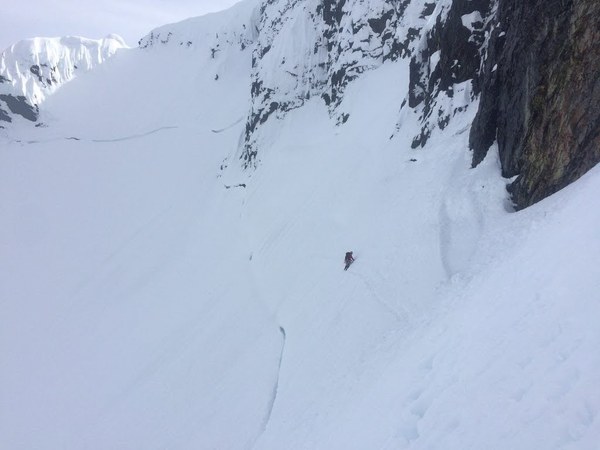
Climbers traversing above the crown to a safer ground climber's left of the end of the 2nd rappel:
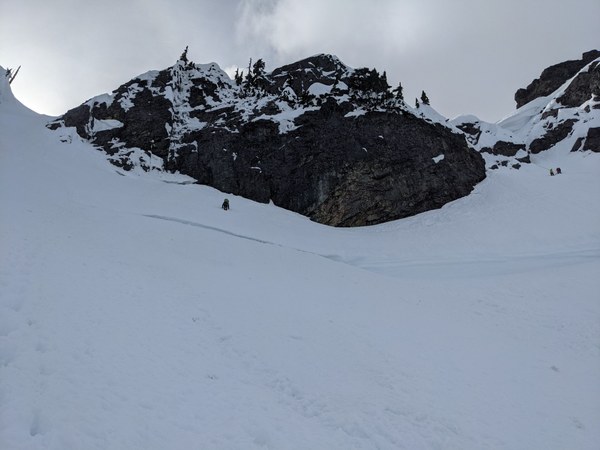
Once under the crown, it was easy downclimb the rest of the way. Snow was ok to downclimb, but too soft to plunge-step, so it had to be a reverse Ueli Steck all the way down.
As an extra curveball thrown by the universe, as I was downclimbing from the second rappel and looking for a way to negotiate the crown, I witnessed a large slide over the neighboring wall, which came in two waves, and was rather terrifying. We were not exactly sure what might have caused it, or where it came from. Avy risk at this elevation was forecasted "low" by NWAC, temps consistently forecasted below-freezing during the day for a dew days in a row. The slide did not come from a gully, as there wasn't one for it to come from, and we couldn't see a failed cornice.
Later, before departing, we saw a couple of large rocks falling down from the top on the eastern face (without causing any further damage), and the face seemed to have less snow on it than what we remembered on the way up. We concluded that what likely happened is either rock, or snow release from the top in turn unleashed the snow on the face, causing a larger section of it to go down at once. Alternatively, this could have been caused a failed chunk of cornice that couldn't be immediately seen from where we were standing.
Avoiding the fresh debris required longer downclimbing to keep a wide safety margin to go around it, and took until 3:50pm, for a total of one hour of downclimbing after the second rappel.
Given the risk of such things happening, I think it's better to forego the usual practice of doing a direct traverse from the rappel gully to the gear stash, to downclimb all the way, and keep a wide margin of safety in any case. Choosing a very low spot for the gear stash, and possibly taking a bit more effort to reach the climb base, also seems prudent.
Jeff keeping his distance from the debris field:
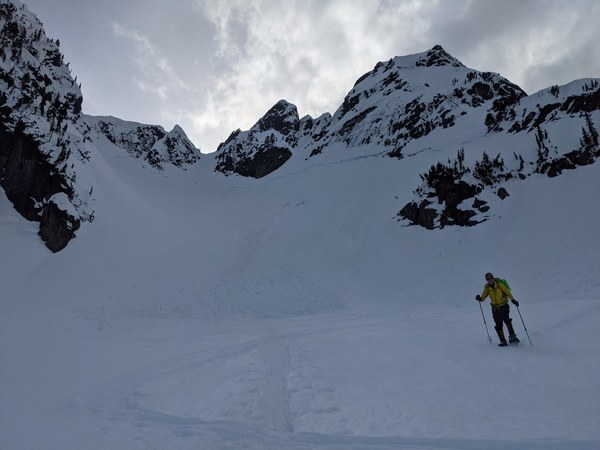
Remaining in the area did not seem safe, so once everyone was finally down, we hurried back. We started the descent around 4:45pm, still slightly ahead of the schedule.
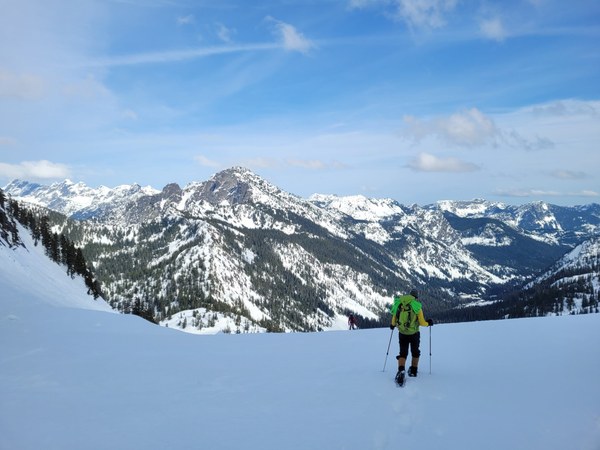
It was still early and bright, and we enjoyed daylight all the way down. Going was a bit slower than usual due to snow softening up and postholing. Still, we reached the autobahn in about 1.5h of plungestep-postholing, or by 6:15pm, and were back to the parking lot by 6:40pm or so, for a total of a little over 13.5 hours car-to-car.
Overall, it was a good day out, although there were some spicier and gnarlier moments than what we anticipated, and going down was tiresome. Compared to my last year's attempt, which was just about 2 weeks earlier during the season, this definitely felt "late". Chair Peak is condition-dependent to begin with, and a few weeks of a Spring-like weather can clearly make a difference. With melting ice and snow softening up, I definitely wouldn't want to attempt it any later, and even this time of the year is later than usual, likely only possible thanks to the heavier than usual snowfall this winter, and a couple of late-season cold spells that kept it in a climbable shape.
In addition to all the fun we had, three climbers (Ashish, Jeff, and Logan) have fully earned their much-deserved ice credits. Everyone placed and cleaned ice screws, kicked and poked holes in ice, swung leads, experienced some exhilarating moments while at the sharp end, plus assorted other bonus spicy fun that all contributes to building solid climbing experience. Awesome job, everyone!
 Krzysztof Ostrowski
Krzysztof Ostrowski